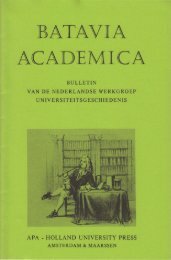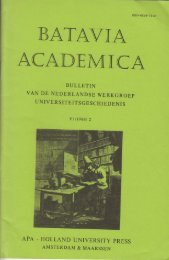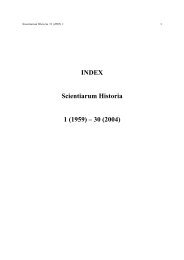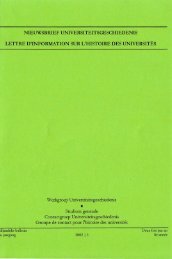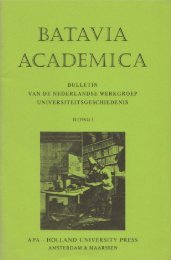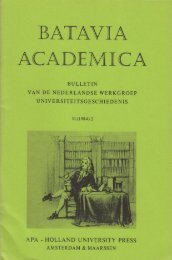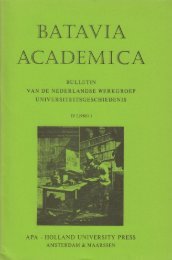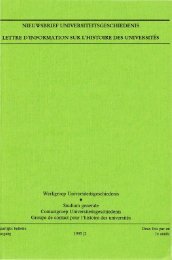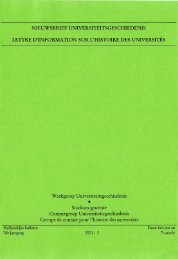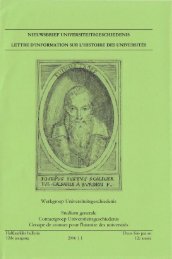the ocular harpsichord of louis-bertrand castel - Gewina
the ocular harpsichord of louis-bertrand castel - Gewina
the ocular harpsichord of louis-bertrand castel - Gewina
You also want an ePaper? Increase the reach of your titles
YUMPU automatically turns print PDFs into web optimized ePapers that Google loves.
Castel's <strong>ocular</strong> <strong>harpsichord</strong> 29<br />
Basically, it has all <strong>the</strong> features <strong>of</strong> <strong>the</strong> 1734 model. All <strong>the</strong> various alternatives<br />
that Telemann mentioned for his one instrument never<strong>the</strong>less make clear that<br />
Castel was still considering different possibilities, to be applied in a definitive<br />
version <strong>of</strong> <strong>the</strong> instrument. A letter from Castel to Montesquieu written in 1739,<br />
published in <strong>the</strong> Memoires de Trevoux, is evidence that Castel was indeed<br />
experimenting with lanterns: "You have seen my lanterns, tuned by colour<br />
degrees and light [chiaroscuro?] degrees ... With lanterns wonderful effects can<br />
be produced using glasses, horn, nettings, taffetas, oiled or ra<strong>the</strong>r varnished<br />
sheets <strong>of</strong> paper, especially when <strong>the</strong> lanterns are made as mobile as mine<br />
are."^<br />
Still in <strong>the</strong> same year <strong>the</strong> Mercure de France published a poem by a certain<br />
Mr. Descazeaux, "Stances sur le mervcilleux Clavecin Oculair", containing such<br />
lines as: "What rapid course <strong>of</strong> shades! What accord in <strong>the</strong>ir differences! For my<br />
charmed eyes what a voice!"^' As four years had pa.ssed since Castel had last<br />
published on <strong>the</strong> <strong>harpsichord</strong>, it is implausible that Descazeaux would have sent<br />
his poem to <strong>the</strong> Mercure if he had not recently seen it, be it only a model, and<br />
been impressed by it.<br />
Again some years later, in July 1741, Georg Wolfgang Krafft, a member <strong>of</strong><br />
<strong>the</strong> Imperial Academy <strong>of</strong> St Petersburg, received a letter from Paris, informing<br />
him <strong>of</strong> Castel's <strong>the</strong>ory. The correspondent mentioned that Castel was busy<br />
building his <strong>harpsichord</strong> and had promised its completion before <strong>the</strong> end <strong>of</strong><br />
1740. The design seemed to be suffering fur<strong>the</strong>r changes, as it was reported that<br />
<strong>the</strong> original plan was to show coloured strips, but that Castel had replaced <strong>the</strong>m<br />
by a painting containing coloured crystals, realizing <strong>the</strong> instrument "in modo<br />
<strong>the</strong>atri comici".'** The report from Paris, for that matter, induced Krafft to<br />
dedicate an <strong>of</strong>ficial meeting <strong>of</strong> <strong>the</strong> academy to Castel's colour music, where he<br />
did away with <strong>the</strong> whole idea, as will be shown in <strong>the</strong> next section.<br />
Castel clearly did not hold to his promise for <strong>the</strong> end <strong>of</strong> 1740, but his<br />
optimism held ground. In 1745 <strong>the</strong> Englishman Alban Butler, visiting Paris in<br />
<strong>the</strong> retinue <strong>of</strong> his employer, <strong>the</strong> earl <strong>of</strong> Shrewsbury, saw <strong>the</strong> "famous instrument"<br />
in Castel's workshop, and his account makes evident that Castel was still far<br />
from his goal: "This instrument is not finished, and gives only three colours."<br />
Butler added circumspectly: "The fa<strong>the</strong>r pretends to entertain hopes <strong>of</strong> making it<br />
Memoires de Trevoux, August 1739, pp. 1676, 1677-1678: "Vous avez vu mes Lantemes<br />
diapasonnces par les degrcs des couleurs & de lumieres ... Par mes lantemes sur-tout on peut<br />
faire des merveilles avec des verres, des comes, des gazes, des taffetas, des papiers memes huil^s<br />
ou plGtot vemis: sur-tout si Ton donnoit a ces I.antemes la mobilite qu'ont les miennes."<br />
Mercure de France, April 1739, pp. 768-769: "Quel rapide cours de nuances! / Quel accord<br />
dans leurs differences! / Pour mes yeux charmes quelle voix!"<br />
Weliek, "Farbenharmonie und Farbenklavier," p. 358.



